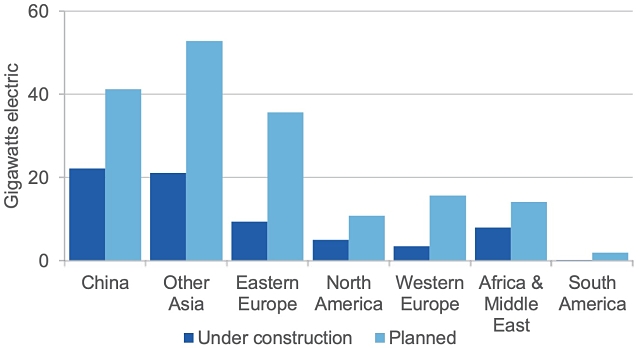Is the long-awaited supply shock finally here for uranium?

COVID-19的影响可能推高铀价,全球供应因工厂关闭而减少。
Canada’s Cameco this week announced it was shuttering Cigar Lake, the world’s largest uranium mine, for at least four weeks after directives from the Canadian and Saskatchewan provincial governments.
The Canadians are concerned about the use of fly-in, fly-out workers while COVID-19 is spreading.
Meanwhile, Namibia, a key supplier of uranium to China’s nuclear fleet, has closed down all mining until the virus comes under control. The country’s large Rossing mine is operated by a state-owned Chinese company.
However, the world’s biggest exporter Kazakhstan is so far sticking to its uranium sales plan, though six of its main cities are now in lockdown.
Back in Canada, Denison Mines has suspended the environmental assessment for the Wheeler River uranium project in Saskatchewan, while New York listed Uranium Energy Corp has postponed plans to resume drilling at its Burke Hollow project in Texas.
And Australia’s Ranger mine is to close next year.
Uranium market
Cameco, Kazakhstan’s Kazatomprom, and France’s Orano are the three main players in the uranium market.
In the past two weeks, the spot uranium price has risen by 14% to hit US$27 per pound, ending a long period locked into a range between US$24/lb and US$26/lb.
The reason given by analysts: just six mines around the world produce two-thirds of the uranium needed to power the 442 reactors across 31 countries. In the past 15 years, China has gone from three nuclear power stations to 45.
Twenty new reactors are due to be connected to grids this year.

Nuclear capacity under construction and planned.
Moreover, another 495 reactors are to be built or are already under construction, with projections of demand reaching 247 million pounds per year (against 170Mlb at present).
Some 85% of that 170Mlb is supplied through long-term contracts.
Additionally, nuclear electricity output increased 2.8% in 2018 – the best growth since 2010.
As reported recently, the latest Resources and Energy Quarterly from the Department of Industry, Science, Energy and Resources has forecast that tight supply conditions will force a lift in uranium prices.
Two weeks ago there was already detectable upward movement in the spot uranium price.
“With supply remaining constrained, reactor constructions in Asia, the Middle East and Eastern Europe should push prices up slowly with a levelling out above US$40/lb by 2024,” the report added.
However, the report’s authors warned that many mining projects had been abandoned or placed in hiatus in recent years, and uranium mines can take significant time to start or restart.
Local uranium players keep the faith
Late last year the local industry was sticking by its plans even after the long, gruelling period of low share prices for the uranium sector.
At its annual meeting, chairman Ronnie Beevor told shareholders in Bannerman Resources (ASX: BMN) that “nuclear energy is finally earning rightful recognition for its clean energy credentials” while Deep Yellow (ASX: DYL) told the market that there were “strong long term fundamentals for nuclear energy”.
Bannerman and Deep Yellow both have projects in Namibia that are being progressed. Deep Yellow said recently its exploration program for 2020 is fully funded for the year.
Less than a month ago, Marenica Energy (ASX: MEY) expanded its land package in Namibia, forming a joint venture to acquire ground adjoining its Koppies project. In February Marenica reported an intersection at Koppies of 3m at 3,087 parts per million (ppm) uranium oxide.
The resource at Koppies stands at 61Mlb grading 93ppm. The junior also has a 484m pound resource at projects in Western Australia and the Northern Territory.
Toro Energy (ASX: TOE) has an advanced stage project near Wiluna that passed its environmental permitting. While it waits for better days, the company is continuing with research and engineering work to improve the value of its project.
Boss Resources (ASX: BOE) has positioned itself as Australia’s next uranium producer, saying that it can fast track start of production in 12 months at its Honeymoon mine in South Australia. Its base case has been calculated at US$50/lb as a long-term price.
The mine is fully permitted to export 3.3Mlb of uranium.
Vimy Resources (ASX: VMY) stated recently its Mulga Rock project in Western Australia will be “mine ready” this year. Key state and federal permits have been finalised and the company has full mining tenure.
Altogether, there are about 19 ASX listed companies with uranium projects, some dormant.
US utilities have held back the spot price
America has 98 nuclear power plants producing 808,078 gigawatt hours (Gwh) of electricity a year, well ahead of France (395,908Gwh) and China (277,056Gwh).
While many of the country’s long term contracts expire over the next two years, the power producers have been reluctant to lock themselves into new ones. (The industry standard is for contracts to be locked in about two years ahead of the first delivery.)
At the same time, uranium miners are also holding off on contracts. The few deals that have been signed over recent months have, so far as industry observers can tell, been at around the US$42/lb market. The miners are said to hoping for something closer to US$60/lb.
They will not be too greedy, though: if the contract price goes much higher than about US$60/lb, it will have other potential uranium producers dusting off their development plans and bringing more competition.
As Bannerman noted in its most recent quarterly report, “significant uncertainties remain, particularly for US fuel buyers, which have hindered procurement actions despite increasing geopolitical risk and a tightening of inventories across the nuclear fuel cycle”.
US utilities have continued to draw down on their existing inventories.
Meanwhile, Cameco will be going into the spot market to buy uranium to replace lost production at Cigar Lake to meet its contract deliveries.
